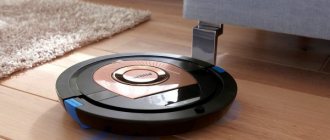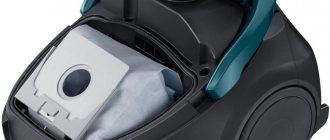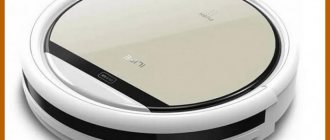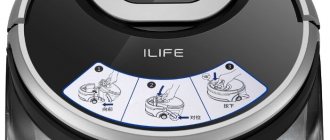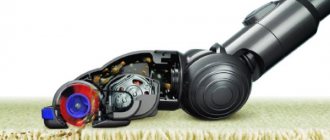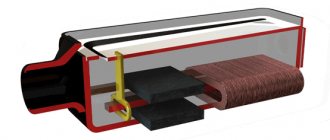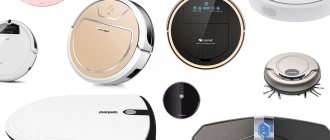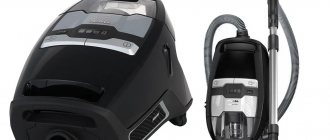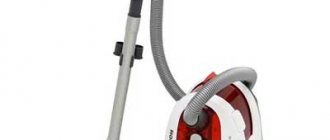Understanding how a vacuum cleaner works, its structure and the main differences between different designs of similar equipment makes the choice easier for a potential buyer. After all, its quality characteristics, consumer properties and maintenance rules depend on the operating principle and design features of the device.
All these points have been studied by us and described in detail in the article. The information presented will help you understand the specifics of the functioning of various types of vacuum cleaners, as well as choose the most suitable option among the variety of designs.
Device and design features
The design of the unit has not changed much over the past hundred years, nor has its performance. Having gone from an electric broom, a manually driven machine, to a gas-powered pneumatic carpet “renewer”, the vacuum cleaner technically settled on the James Spangler model.
An Ohio janitor has created a revolution by creating an upright and portable machine out of a broom, a pillowcase and an electric motor. Spangler's invention was sold under the Hoover brand. The modern device inherits the same design of the electrical part, brush and dust collector.
Hoover vacuum cleaners are the first to use aluminum in their housings. This happened around 1923
The main components of a conventional vacuum cleaner:
- Centrifugal compressor - creates a vacuum and pumps air.
- The commutator motor drives the compressor.
- Air purifier - separates dust from the air and collects it in special containers.
- A set of attachments and brushes for various purposes.
The device body itself is made of durable plastic. An engine, compressor, dust collector, filters, and control unit are built inside it.
The standard household design of a vacuum cleaner is equipped with a flexible air hose and extension tube. The exceptions are small-sized manual models and devices where the compressor is built into a tube with a nozzle or brush.
Any vacuum cleaner also has a three-level filtration system through which the sucked air is passed. It consists of a main, motor part and a fine filter (sometimes a container of water serves as a filter)
In order to expand the scope of application, manufacturers equip the devices with different attachments.
The universal one is always present in this set. It is designed for cleaning flat horizontal surfaces and carpets. The design includes switches, rollers for maneuverability, and brushes with different bristles.
The crevice nozzle is convenient for cleaning hard-to-reach places (corners, gaps, spaces between the wall and furniture). There are also collapsible 2-in-1 designs - universal plus a removable surface with pile
A separate variety is represented by turbo brushes, the structure of which allows you to collect wool and hair from carpets. Relatively recently, electric brushes, cylindrical rollers, nozzles for parquet, metal debris, cleaning siphons and others have appeared.
Vacuum cleaner device
The main components of a modern vacuum cleaner are:
- A centrifugal compressor that creates a vacuum and pumps air through the filters and air ducts of a vacuum cleaner. The compressor is almost always driven by a brushed motor;
- An air purifier that separates dust from the air and collects it in a dust collection container;
- A set of replaceable attachments and brushes for effectively removing dirt from various surfaces (carpets, parquet, furniture, hard-to-reach places, etc.)
Typically, a vacuum cleaner is equipped with a flexible air hose (with the exception of small-sized hand-held models and some vacuum cleaners of the “American” design with a compressor built into a pipe with a brush or nozzle), an extension pipe, as well as attachments that expand its functionality (spray nozzles, nozzles for inflating balls, etc.). Vacuum cleaners can be floor-standing, manual, backpack, brush-vacuum cleaners, centralized and automatic (robotic).
How do different types of devices work?
All vacuum cleaners perform one function - cleaning. Why do devices, invented and manufactured with a single purpose, differ so much from each other in shape, size, and principle of operation?
When you first get acquainted with the device, the location of the dust collector, the number of wheels, or the material from which the hoses are made do not seem important. Understanding the significance of each detail comes during operation.
Let us analyze the design features and operating principle of the devices depending on the types of dust collector and the functionality of the devices.
Vacuum cleaner with bag or container
Schematically, the operating principle of this device can be represented as follows. Through the nozzle and hose, dust-filled air enters the device, namely into the dust collector - a bag or cyclone filter.
In a vacuum cleaner with a container, the garbage first falls not into a bag, but into a special centrifuge container, where large fractions are retained
Then one part of the dirt remains in the container, the other moves through the pores and vortex flows of the storage tank towards the motor. To protect it, a coarse filter was invented.
But it is not ideal either - the dirt travels to the outlet and approaches the fine filter (HEPA).
Compact vertical units
The peculiarity of this design is the absence of a hose. It is sometimes included in the kit and can be used to perform individual manipulations. The role of the main dust absorber goes to the brush - turbo or “beater”.
Modern vertical devices can interface with smartphones, thanks to which the owner can programmatically adjust the suction power, see how many kilometers the home assistant has traveled and other information
The motor and dust collector in the device are located in a pipe - the body of the unit. The motor does not so much create suction force as it rotates the brush shaft. In this case, the garbage seems to be “swept” into the dust collector.
Vertical models also have a suction module. But it is used when the device is used as a horizontal one.
Water filtered design
Vacuum cleaners with an aqua filter provide a different method of cleaning the incoming air, hence the structural features. The device is externally similar to a conventional container-type vacuum cleaner - it includes a nozzle and a hose, from which debris falls into the dust collector-aquafilter.
But the latter is made in the shape of a flask with water. The engineers' idea is for debris and dirt to sink under the influence of vortex flows.
What creates these flows? A turbine or separator rotating inside the flask. This visible part of the engine swirls dust and creates high pressure. The latter “captures” particles regardless of size, immerses them in water and does not give them a chance to get out.
In such devices, the shape of the turbine and its rotation speed are important. Manufacturers still have to add filters to designs that are not technically well thought out. The statement applies to budget separator models.
In a device with a Krausen aquafilter, dust moves through the pipe (1) into the aquafilter (2), then the separator (3) creates water-vortex flows (4) and reaches the ideal air purification coefficient (5)
These vacuum cleaners cannot be called completely filterless either, because they contain a protective filter for the motor. Only German engineers managed to get rid of it, who “sewed up” the motor into a stainless steel capsule. In this case, the motor is securely protected from dust and wet dirt.
Complex built-in modifications
These devices are not portable and are mostly mounted inside the walls. Their nozzles and hoses are not connected to the body of the vacuum cleaner, but are inserted into pneumatic sockets located throughout the intended operation area of the device.
Built-in vacuum cleaners are not very common in everyday life due to the need to use long hoses, which makes it difficult to perform comprehensive cleaning of premises.
A complex chain of air ducts is installed in the walls, through which the collected waste is directed to a common dust collector. The latter is located in utility rooms or in the basement, if available.
The unit itself includes both the engine and filters. The power plant is also often located in utility rooms.
General structure and operating diagram
Regardless of the form factor and purpose, the design of vacuum cleaners of all types is almost the same . They consist of a long flexible tube, at one end of which a brush is attached, and the other is connected to the device itself. Inside the vacuum cleaner there are:
- bag or container for collecting garbage and dust;
- filtration system for purifying exhaust air;
- an engine that is responsible for suction (today the most common are motors with a power of 1500 or 1800 Watts, while modern models are not as noisy as the Soviet “Raketa” and “Chaika”).
- a metal or plastic case in which all of the above elements of the unit are hidden.
The principle diagram of the operation of any vacuum cleaner is as follows. The engine creates rarefied air inside the housing, and as a result of the difference in pressure, air masses from the outside are sucked in along with debris and dust. The dirty stream enters the dust collector, where the main debris is filtered out by the walls of the bag, water (in devices with aquafilters) or using cyclone technology. Small parts of dust that are not retained in the walls of the dust collector enter the fine filtration system, consisting of dense, finely porous material. The air that passes through these filter elements is almost completely freed of suspended particles. In this way, debris is removed as much as possible from the incoming stream.
Features of washing machine models
The main design difference between washing machines and models with a bag and container is the presence of a reservoir for clean and dirty water. Small and large fractions of dirt sink in such a container.
The main advantage of such a tank is that the owner does not have to breathe dust while emptying the tank.
The design of the washing vacuum cleaner has an additional reservoir for water and detergent, a pump, liquid supply channels integrated into hoses and tubes
But the design of washing vacuum cleaners also includes protection of the motor from moisture, which significantly increases the cost of the vacuum cleaner. And wet dirt accumulates on the HEPA filter, which creates a breeding ground for many bacteria.
There are washing vacuum cleaners with a steam generator. This device allows you to clean surfaces with steam without the use of chemicals.
High-tech robotic vacuum cleaners
Robot vacuum cleaners only appeared about 10 years ago. Their designs are constantly updated and improved. The devices are created according to a block design. This ensures ease of maintenance and ease of replacement of parts during repairs.
Common elements of a robot vacuum cleaner that are found in all models:
- side brush;
- block module;
- charging base;
- sensors for detecting obstacles, pollution, height differences.
The operation of such a device is based on a cleaning unit, navigation, drive mechanisms and a battery device.
Gadget navigation systems
The state-of-the-art navigation system consists of a laser, camera, internal and external sensors. The camera reads a map of the room. Rangefinder lasers transmit information to her about the presence of objects in the room and the distances between them.
The device moves in straight lines both during cleaning and during the process of returning to the base.
Robot vacuum cleaners do not yet know how to go down stairs or overcome high thresholds. Developers are trying to eliminate this defect in gadgets by inventing new models.
There are still models on sale whose operating principle is based only on sensors. They are located on the outer body of the device and inside it.
With their help, the robot navigates in space and adjusts its work, and also notices the most contaminated areas and is more careful in cleaning them.
Magnetic tape can also be used to navigate the robot. It creates a virtual barrier beyond which the device does not move. If the cleaner is equipped with a camera, it takes readings from the ceiling and walls.
Cleaning process
Here, the models differ in types of cleaning - dry cleaning and washing robotic vacuum cleaners. In the first, the side brush picks up all the dirt and directs it to the central brush. The central one has a fleecy surface and is capable of collecting hair and wool.
The design of the front brush of the robot is installed with an inclination into the device, and the side one has flexible wires, which ensures thorough collection of debris
Then these two parts send the garbage to the dust collector, where it is compressed by air currents. And the air passes through the filters to the outside.
Depending on the manufacturer, robot designs differ in the following nuances:
- Basic brushes . Most models have two of them - fleece and rubber. They work in pairs. Some devices are equipped only with rubber.
- Side brushes . There are devices that have an additional side brush built into them.
- Filters . The robots are equipped with both standard “napkins” and multilayer HEPA.
- Container + engine power . The waste collection container can have a volume from 0.4 to 1 liter. The power of such devices is 40-65 watts. If the first numbers are important during operation, then the second ones are unimportant due to the small range.
The main consumer part of robotic vacuum cleaners is the main brush. The quality of cleaning depends on it, and not on the engine, as with conventional units.
A wet vacuum cleaner has in its design a system of a water tank and a sprinkler. It can collect debris, spray liquid, polish the floor and collect dirty water back into the reservoir.
There are robot models designed for mixed cleaning. The principle of their operation is to clean smooth surfaces with a rag, and carpet surfaces with basic brushes.
Return to base
The final stage of the robot’s work is its return to the mother base. The device is powered by batteries. If they are discharged, the device turns off.
There are robots with a program that leaves the device at the cleaning site, and the user forces the return to the base
The device automatically reacts to a low charge percentage. Using a special sensor, it detects an infrared beam from the base and begins to move towards it. As soon as it finds it, it docks with it and charges.
Noise level
Noise depends not only on the installed motor, but also on the power of the vacuum cleaner and filtration system. At higher powers the noise increases significantly. In modern vacuum cleaners, the noise level is in the range of 55-90 dB. The noise level of human conversation is 65dB. Models of vacuum cleaners with S-class filtration are the quietest, but the cost also increases significantly.
So, depending on the purpose and needs, modern vacuum cleaners are divided into:
However, the cost of such vacuum cleaners is an order of magnitude higher than that of traditional dry cleaning models. A washing vacuum cleaner requires thorough drying after cleaning. In rooms with high humidity, the device may not dry out completely, resulting in a swampy smell.
Read also: What kind of drill is needed for confirmat
Classic floor vacuum cleaner for dry cleaning : a horizontal body on wheels (motor unit, dust compartment, filters), a hose connected to it, a suction pipe, nozzles for cleaning various surfaces (not only floors, but also upholstered furniture, cleaning clothes). With rare exceptions, they operate from the mains. Rechargeable ones are still not very common.
Vertical vacuum cleaner : monoblock with a center of gravity shifted downward (motor unit, dust container with filters, main brush attachment). Or the motor with a dust collector can be on top, like in Dyson vertical vacuum cleaners. There are models of the “2 in 1” format - the motor unit with a dust collector (suction module) is removable - for quick local cleaning of different surfaces. There are cordless vertical vacuum cleaners, but there are also those that work from the mains, they are more powerful.
Robot vacuum cleaner : self-propelled, body height up to 19 cm (but this is a lot, focus on 6-10 cm - so that the robot cleans under beds and in other hard-to-reach places). Electronic “brains” process information from various sensors on the body and from cameras to create the optimal route for autonomous cleaning of the room. Plus, of course, a motor, a dust container, an air filter, and rotating brushes of various types that help debris get inside the vacuum cleaner.
Portable vacuum cleaner : motor and dust collector in a small body, different attachments. There are mains-powered and battery-powered models. They are useful for quickly cleaning up spilled items, crumbs, dust from furniture, in a car (there are those that can be started from the cigarette lighter).
Washing vacuum cleaner : in the body there is a motor, a water tank with detergent, for dirty water (also known as an aquafilter). The cleaning solution is sprayed through connecting tubes onto the contaminated surface (carpet, hard floor) and immediately, along with the dirt, is sucked up by a vacuum cleaner through a special nozzle and hose. These vacuum cleaners clean efficiently, but are often bulky and difficult to maintain.
Removable, reusable container . Its volume depends on the model. This one needs to be cleared of debris from time to time. If you do this carefully, contact with dust can be minimized. Plus, manufacturers are introducing various technologies to make the process more hygienic. But there are no additional expenses, as when using disposable paper bags.
Dust bag . In modern vacuum cleaners, you can use disposable paper bags (purchase additional ones as needed) or a reusable bag-type dust collector, which must be emptied from time to time. Bag vacuum cleaners suffer more from a decrease in suction power as the dust container fills than bagless vacuum cleaners.
Dust collector-aquafilter . All collected debris remains in the water container inside the vacuum cleaner. Purified and humidified air passes through the motor unit, additional filters and returns to the room. There is no contact with flying dust when emptying the container - you simply pour out the dirty water. But this must be done after each cleaning, wash and wipe the aqua-dust collector dry.
There are hybrid vacuum cleaners where you can use an aqua filter or, for example, a removable dust container (bag) - as needed.
Constructive details and quality of cleaning
Some design features of the device affect the quality of cleaning and ease of use. For example, a hose. It must be of sufficient diameter (at least 5 cm) so that it does not become clogged frequently.
The length of the flexible hose is important - the longer this accessory, the more convenient it is to clean. Especially in rooms of 15 square meters. and more. A length of 2.5 m is needed for cleaning high furniture and ceilings
The strength of the material is also important, otherwise the part will crack, which will reduce the suction power.
In addition to the main components, the quality of operation of the device is also influenced by seals, bushings, and bearings. If the joints are made of fluoropolymers, this ensures their tightness.
Bushings and bearings made of fluoroplastic and polyamide extend the life of the moving parts of the device.
Additional information about different types of vacuum cleaners, as well as tips on choosing the right unit, is provided in this article.
Conclusions and useful video on the topic
Analysis of the design and operating principle of a vacuum cleaner with pressure sensors and two electric motors - in the brush and the body of the device.
The examples of several designs of vacuum cleaners clearly show that, regardless of the type, they all serve equally as “dust cleaners.” Their effectiveness depends on the filtration system, engine power, and the presence of various nozzles.
Which vacuum cleaner did you choose for your home or apartment? Please tell us why you chose a particular model, and whether you are satisfied with the performance of the purchased equipment. Add reviews, comments and ask questions - the contact form is below.
Choosing a vacuum cleaner by type of design
The history of the evolution of vacuum cleaners goes back more than a hundred years; no fundamental changes have occurred during this time. However, the variety in the product range has increased. Manufacturers of household appliances first of all make structural additions to the device of the vacuum cleaner; the filling and operating principle change slightly.
Read also: CNC engraving on metal
